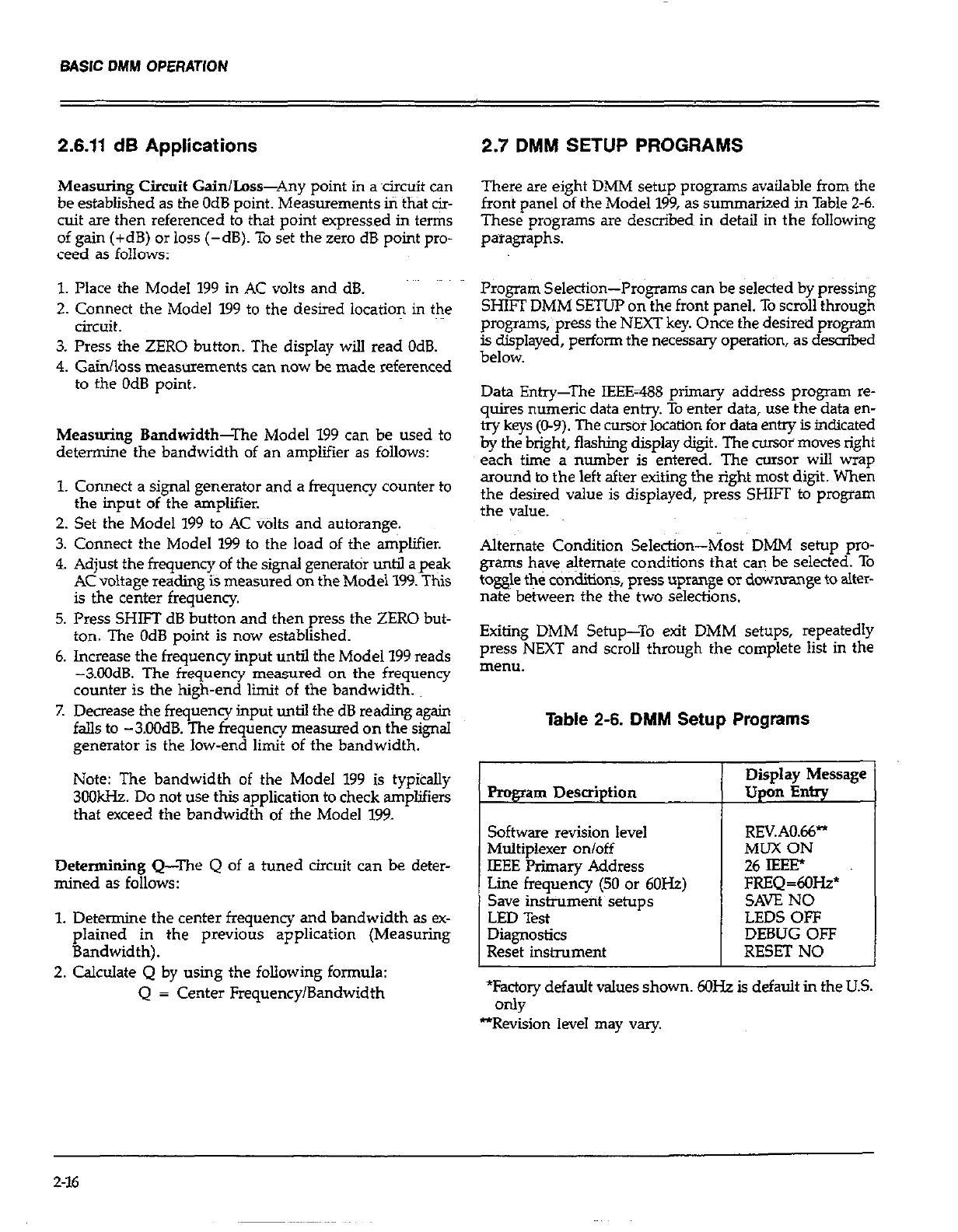2.6.11 dB Applications
2.7 DMM SETUP PROGRAMS
Measuring Circuit Gain/Loss-Any point in a circuit can
be established as the OdB point. Measurements in that cir-
cuit are then referenced to that point expressed in terms
of gain (+dB) or loss (-dB). To set the zero dB point pm-
teed as follows:
There are eight DMM setup programs available from the
front panel of the Model 199, as summarized in Table 2-6.
These programs are described in detail in the following
paragraphs.
1. Place the Model 199 in AC volts and dB.
2. Connect the Model 199 to the desired location in the
circuit.
3. Press the ZERO button. The display will read OdB.
4. Gainlloss measurements can now be made referenced
to the OdB point.
Program Selection-Programs can be selected by pressing
SHIFT DMM SETUP on the front panel. To scroll through
programs, press the NEXT key. Once the desired program
is displayed, perform the necessary operation, as described
below.
Measuring Bandwidth-The Model 199 can be used to
determine the bandwidth of an amplifier as follows:
1. Connect a signal generator and a frequency counter to
the input of the amplifier.
Data Entry-The IEEE-488 primary address program re-
quires numeric data entry. To enter data, use the data en-
try keys (O-9). The cursor location for data entry is indicated
by the bright, flashing display digit. The cursor moves right
each time a number is entered. The cursor will wrap
around to the left after exiting the right most digit. When
the desired value is displayed, press SHIFf to program
the value.
2. Set the Model 199 to AC v&s and autorange.
3. Connect the Model 199 to the load of the amplifier.
4. Adjust the frequency of the signal generat& until ape+
AC voltage reading is measured on the Model 199. This
is the center frequency.
Alternate Condition Selection-Most DMM setup pro-
grams have a&mate conditions that can be selected. TO
toggle the conditiop, press uprange or dowmange to alter-
nate between the the two selections.
5. Press SHIFT dB button and then press the ZERO but-
ton. The OdB point is now established.
6. Increase the frequency input until the Model 199 reads
-3.OOdB. The frequency measured on the frequency
counter is the high-end limit of the bandwidth.
7. Decrease the frequency input until the dB reading again
falls to -3.OOdB. The frequency measured on the signal
generator is the low-end limit of the bandwidth.
Exiting DMM Setup-To exit DMM setups, repeatedly
press NEXT and scroll through the complete list in the
UlH-l”.
Table 2-6. DMM Setup Programs
Note: The bandwidth of the Model 199 is typically
3CKlkHz. Do not use this application to check amplifiers
that exceed the bandwidth of the Model 199.
/ Program Description
Determining Q-The Q of a tuned circuit can be deter-
mined as follows:
1. Determine the center frequency and bandwidth as ex-
plained in the previous application (Measuring
Bandwidth).
Software revision level
Multiplexer on/off
IEEE Primary Address
Line frequency (50 or 6OHz)
Save instrumerit setups
2. Calculate Q by using the following formula:
Q = Center Frequency/Bandwidth
Reset instrument
REV.A0.66+’
MUX ON
26 IEEE*
FREQ=6OHz’
SAVE NO
LEDS OFF
DEBUG OFF
RESET NO
*Factory default values shown. 6Oti is default in the U.S.
O=lY
Display Message
upon Entry
J
“Revision level may vary.
2-16

